
In this fifth chapter of the dossier on worker-owned cooperatives in the United States I will present the recent movements that are leading the worker-owned cooperatives beyond the examples which have arisen spontaneously discussed in the previous chapters, and I will show examples of realities hand-designed by universities, foundations, with the involvement of local City governments, the Congress and even with a hand of the Obama federal government, all organizations that are able to field billion of dollars of investment if they want. Why these traditional institutions take an interest in organizational forms of worker-owned cooperatives? Not for an abstract concept of equality and direct democracy, but because it is now recognized that the model of the new liberalism robbery that reigns in the world is now sending to the bottom the economic power of the United States, that without a manufacturing base can no longer maintain its global economic superiority, that China, India and Brazil are rising from below and the new poverty in the U.S. generated by all the closures of industrial plants cannot be overcome using only the traditional forms of work organization.
So the United States do what they have always done when they were at a disadvantage in some fields: in the past they have imported the brain of Enrico Fermi to take advantage in the Atomic Energy Agency, that of Von Braun to convert his Nazi V2 in the American space program, they import today numerous scientists and researchers in various fields.
Those who have realized that the economic model of unbridled neo-liberalism is a suicide for the United States, beginning with academics from different universities, they looked around, saw which business organizations are working better around the world and have looked to cooperatives, including the Italian ones, and addressed their interest on the model of the Mondragon cooperatives of the Basque Country, Spain. A completely practical approach, very far from theoretical considerations. They do not discuss Proudhon and Owen or Mill and Pareto (or just discuss it a little and in a few) they have looked at what works best in the world and have chosen the Basque Mondragon, which also refer to Owen, as a model to study and take inspiration from which to build the new economy, but without slavishly copying them but adapting their organizational forms to the realities and culture of their country. Will it work? So far the signs are very positive, especially in light of the examples that I presented in the previous installments, which have been successful for tens and tens of years, some for thirty.
Enrico Massetti
enricomassetti@msn.com
Workers of the World, Incorporate
In a remarkable and historic move, the United Steel Workers union (USW) and Mondragon International announced that they would be working together to establish Mondragon manufacturing cooperatives in the U.S. and Canada. The Mondragon Cooperative Corporation (MCC) is the world’s largest industrial workers cooperative, located in the Basque region of Spain. It employs almost 100,000 workers in 260 cooperative enterprises that include manufacturing, a university, research and development, social security mutual, and retail shops. In 2008, MCC reached annual sales of more than 16 billion euros and is ranked as the top Basque business group, the seventh largest in Spain..
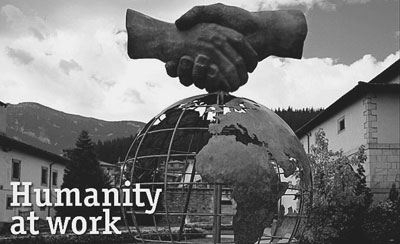
Inspiration
In the cooperative world, Mondragon, despite criticism of the compromises that it has made in the face of globalization, is still the gold standard of success and has inspired many other cooperative initiatives in other countries.
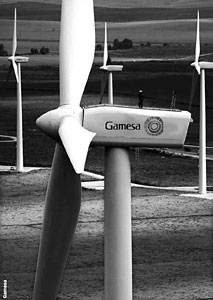 |
A wind park with
Gamesa turbines
|
New frontier
It is clear that Mondragon is a source of inspiration for many other initiatives to build economic democracy. The collaboration with the United Steelworkers raises the potential to a whole new sphere of possibilities.
The USW-Mondragon collaboration grew out of a USW ‘green industrial revolution’ project that created a partnership with Gamesa, a Spanish wind turbine firm, to establish production in Pennsylvania by refitting shuttered steel plants. Gamesa is based near Mondragon and it wasn’t long before one thing led to another and the USW-Mondragon connection was made. Discussions and meetings followed over the course of the following year and culminated in this historic agreement to create worker cooperatives in the manufacturing sector, either through worker buy-outs or new start-ups. Other aims include integrating collective bargaining with the cooperative model and exploring co-investing through the USW backed Quebec Solidarity Fund and Mondragon’s Eroski Foundation.
The United Steelworkers (USW) is the largest industrial union in North America, representing 1.2 million members in a diverse range of industries. In a time where labor unions and worker cooperatives have drifted far away from their common roots—when worker cooperatives were seen by some unions as a way to eliminate the class struggle between owner and worker—it is enormously significant for a union of this weight and history to reforge those alliances. It is a signal to the labor union movement as well as the wider public that cooperatives are part of the solution, not some alien phenomenon from a parallel universe. USW spokesman, Rob Witherell said that the collaboration was not a hard sell. Most of their members had been unfamiliar with the concept of worker coops, but once it was explained, they easily ‘got it’ and were very interested.
We continue to see rising unemployment, stagnant wages, cuts in benefits, deteriorating workplace conditions and the hollowing out of our manufacturing sector. This announcement breathes hope of reviving our manufacturing base and rebuilding communities that have been devastated by plant closings. Rising oil and transportation prices, combined with the falling dollar are creating the conditions for a manufacturing renaissance in the U.S. Imagine if this renaissance could be infused with, as USW President Leo Gerard said, “Mondragon’s cooperative model with ‘one worker, one vote’ ownership as a means to re-empower workers and make business accountable to Main Street instead of Wall Street.”
And when workers own and run the factories they work in, they’re not likely close up shop at the first sign of stress—in, over fifty years of operation, Mondragon has only seen three of its cooperative enterprises fail. Imagine.
Says USW's Rob Witherell: “Initially we are looking to convert an existing manufacturing operation...”
Witherell stresses that the union aims to implement the basic principles of worker ownership and democratic governance rather than precisely replicate the Mondragon model. Still, he says, success comes down to well-run companies that meet a need. “The people who formed these co-ops did not do so because of some egalitarian ideal — they did it out of the necessity to feed and provide for their families.”
thanks in part to Emily Kawano, Center for Popular Economics Exec. Dir.
|
Nancy Folbre,
professor of
economics at the
University of
Massachussetts. |
CO-OPS are on the rise also in the media
The budding alliance between the United Steelworkers (USW) and the Mondragon Cooperatives raises the general awakening consciousness about worker co-operatives and co-operative business in general.
In an article on the New York Times Economix blog by Nancy Folbre, an economics professor at University of Massachusetts, in “The Case for Worker Co-ops” says, “Since many of our most prestigious economic institutions have embarrassed themselves at our expense over the last year, maybe it’s time to look around . Worker-owned and -managed businesses combine the romance of entrepreneurship with solid family values and commitment to community. What’s not to like?”
But all this attention being paid to worker co-ops makes Folbre, the economist, wonder what the economic research says. Not much, according to her. Worker owned and managed companies are “largely ignored in economics textbooks.”
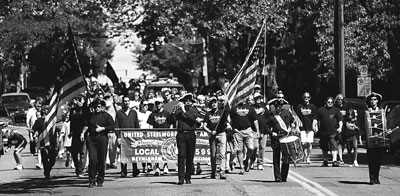 |
Bethlehem, PA, September 5, 2010, members of the
Whiteall Fife and Drums Guard lead the Steelworkers and
Friends Labor Day parade |
 The Evergreen Cooperatives of Cleveland, OhioThe Evergreen Cooperatives of Cleveland, Ohio are pioneering innovative models of job creation, wealth building, and sustainability. Evergreen's employee-owned, for-profit companies are based locally and hire locally. They create meaningful green jobs and keep precious financial resources within their community. Their workers earn a living wage and build equity in their firms as owners of the business.
The Evergreen Cooperatives of Cleveland, OhioThe Evergreen Cooperatives of Cleveland, Ohio are pioneering innovative models of job creation, wealth building, and sustainability. Evergreen's employee-owned, for-profit companies are based locally and hire locally. They create meaningful green jobs and keep precious financial resources within their community. Their workers earn a living wage and build equity in their firms as owners of the business.
Evergreen is a partnership between the residents of six of the city's neighborhoods and some of Cleveland's most important “anchor institutions” -the Cleveland Foundation, the City of Cleveland, Case Western Reserve University, the Cleveland Clinic, University Hospitals, and many othersi.
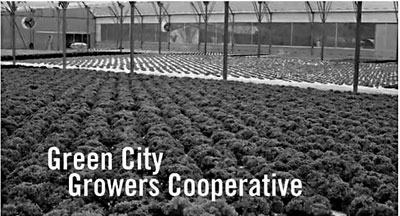
Evergreen Cooperative Laundry
ECL is a Worker Cooperative designed by the Ohio Employee Ownership Center (OEOC) at Kent State University and a product of the Greater University Circle (GUC) initiative and The Cleveland Foundation.
The vision of ECL is to advance green initiatives in the healthcare industry by helping their customers to reduce operating costs, lighten their carbon footprint and invest in local community development.
ECL “owners” receive superior training in operations, life-skills, sustainability and ownership principle empowering their performance at work..
From the video “The evergreen cooperatives”: http://youtu.be/Gt_ZHUDhKjs |
Poverty cannot be eradicated by simply creating jobs but by creating wealth
Steve Kiel, Ohio Cooperative Solar CEO
“This is more than a job, this is an ownership opportunity.”
Mieyon Smith, Evergreen Laundry worker-owner
“… I envision as being one of the owners that make decisions about everything and expanding...”
Tracie Marsh, Evergreen Laundry worker-owner
“...I had some good people out there that believed in me, and gave me a second chance, and, so, I can plan for my future now...”
43,000 people live in Greater University Circle neighborhoods with median income less than $18,500
Ted Howard, Democracy Collaborative
“Over the next three to four years we can create somewhere 500 to 600 jobs in these low income neighborhoods at the University Circle...This is a laboratory for a new kind of economic development...”
Derrik Davis, Sr, Evergreen Laundry worker-owner
“… This is a career, it's not just a job...”
Bob Eckardt, Cleveland Foundation
“This is different, it is higher risk, it's not based upon the social service model, but the business model and the coop ownership model.”
Frank G. Jackson, Mayor, City of Cleveland
“Cleveland wants to be where the world is going, not where the world is.”
In October 2009 Evergreen launched, and the mainline media noticed the event:
“Cleveland looks to green business to power revitalization” - NBC Nightly News
“Buying local on a large scale” – Business Week
“In Cleveland worker-coops look to a Spanish model” – Time
“An effort aimed at closing this wealth gap by creating 10 green, for profit businesses that local residents will own and operate” – The Economist |
Ohio Cooperative Solar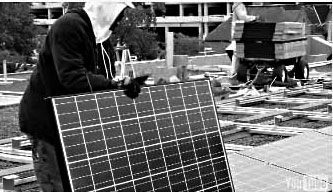
The cooperative has begun to install photovoltaic panels on the three anchor institutions that are part of Cleveland's economic empowerment zone: Case Western University, University Hospitals, and the Cleveland Clinic.
The cooperative will install, own, and maintain the panels that they install and sell the generated power to the host institutions. As a for profit business they are entitled to government solar incentives that non-profit universities and hospitals cannot receive. Because solar installation is not a year-round business in Ohio, the cooperative diversified with a weatherization program for the colder months in order to create full-time jobs.
CEO Steve Kiel, who says he is like an employee of the cooperative's 20 worker-owners, explains his goals include structured wealth creation for the workers' long term economic security. A share of the company's surplus is allocated to the workers but retained in the company, capitalizing the business while creating long-term individual savings.
Ohio Cooperative Solar, offers weatherization services and solar-panel installations — the first a 100-kw system on the roof of the Cleveland Clinic. According to Kiel, Ohio now has 2 solar megawatts of the 60 the state requires by 2012. “Most installations in Ohio are small,” he says. “One hundred kilowatts is a pretty significant system.”

Kiel, who as a business owner and management consultant has worked with nearly 200 companies of varying scale, says he has already seen advantages to employee ownership. “Since the business belongs to the workers, my job [as CEO] is exposing them to how to run a business,” he says. “In addition to the technical training, we're training in administration and managerial skills — how to obtain work orders, track profitability, read a financial statement.” Unlike the typical workplace, here employees know exactly how much the company — and each individual — is making. “There's a value in dealing with an informed workplace,” says Kiel. In terms of problems that can arise, including safety, production and theft concerns, “if people feel a part of it, that makes solving the problem a lot easier.”
He adds that the spread between the high and low salaries is limited so that the CEO earns no more than five times the lowest-earning entry-level employee. This follows the Mondragon template, which keeps the ratio down to 1 to 4 or 5 (though in a few cases of specialized positions, it's as high as 1 to 9).
“...Since these are worker-owned I feel to a great degree that what I am doing is working for these owners, so I am employed as a coach, using my skills and past experiences to show them, not to tell them how things are to be done.”
A Ohio Solar worker-owner:
“...I feel that I am part of this company versus working for this company. I just don't work for it, I am a part of it. I am an office manager-dispatcher, I feel that I have a place in here, I belong in here... Being that it is an employee owned company is wonderful because you get to help make the decisions on what is going to happen in the company, you can actually help make the company or break the company, in either way that's very important, I have never worked for a company where I had this opportunity, it's like being part of the board, you know... You get a portion of whatever the company makes, you get a portion put into a savings account for you, it's not that it's available for you right away, but in the long term definitely I see myself doing better down the line... If I had to do it by myself, no, but with the company managing it for me, yes, definitely I see that when I get ready to retire it will benefit me...”.
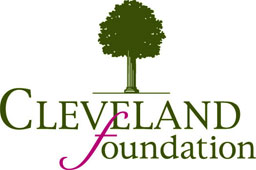 The Cleveland Foundation
The Cleveland Foundation
stablished in 1914, the Cleveland Foundation is the world's first community foundation and the United States' second-largest today, with assets of $1.87 billion and 2010 grants of nearly $85 million. The foundation improves the lives of Greater Clevelanders now and for generations to come by building community endowment, addressing needs through grant-making, and providing leadership on vital issues.
What is a Community Foundation?
A community foundation is a charitable organization created by and for a community of people. It is supported by local donors and governed by a board of private citizens who work toward the greater good of the citizens in the community. Funds come from a variety of sources, including bequests and living trusts, and are invested in perpetuity. The earnings on investments are then distributed to worthy organizations or causes. Today, more than 1,000 community foundations exist around the world.
Grant-making
For more than 95 years, the Cleveland Foundation helped innovative ideas and programs come to life in Greater Cleveland's nonprofit community through their grant-making.
Their impact can be felt all over Northeast Ohio – in metropolitan parks, cultural institutions, neighborhoods, and schools. They help give root to generations of new leaders through scholarships and internships. Their outreach touches people through all life's stages, from prenatal months to elder years.
|
Mendrick Addison, manager, Evergreen Laundry Cooperative
“As an owner you do pretty much whatever is needed, I mean, whatever, often I do things that the average person would say, you know, you are a manager... but we do whatever is needed to keep the business going...”
“...This is my neighborhood, this is where I grew up [now there are all these boarded houses], this is one of the neighborhoods that was hit really hard by the foreclosures,... you know, you feel kind of cast aside, thrown away, and in a sense to have some positive, like some initiative come by it was like a godsend, you know, it was just what the neighborhood needed. We can't help everybody, but we help somebody, you know.”
The Laundry coop is the greenest commercial laundry in the state of Ohio, but the real bet was on jobs.
“Whenever we started people said that we were going to fail, because of who we hired [the poor people we hired], and our bet was we gonna succeed because of who we hire, you know. When you hire people that this is going to be their last chance to have a productive future, of doing something for their children, so, you know, those people have their back to the wall, they say “Hey, I can't mess this up”, you know. That's where we have been, that's where we have been.”
Ted Howard of Community Wealth, a group that provides tools and information on community-based economic development.
“The challenge is: can we build a network of 75 to 100 coops each of them employing 50, 60 or 70 people? Many cities have populations that are locked in the inner-cities, who are locked in generational poverty, generation after generation they simply cannot get out of it. The strategy here is to tap into the big budgets of some of the major institutions in the City. The big three anchors in Cleveland, the Cleveland Clinic, the University Hospitals and Case Western together purchase over three billion dollars of goods and services and very little of that currently is sourced locally. They are the legacy of the manufacturing strength of Cleveland a few decades ago, of fifty years ago, and they are the kind of businesses that don't get up and move. The coops are pressuring these institutions to shift business towards them, so the money turns into local inner-city jobs. It's extremely heartening to see these big institutions, which aren't going anywhere, to come to the realization that their fate is bound up in the fate of the community, that they are not islands onto themselves, that if they are going to succeed in their business model the community needs to succeed as well. They are extremely forthcoming and supporting of this strategy.”
And what's happening in Cleveland doesn't stop in Cleveland, it's turning into a national coop movement. We stopped at a national coop conference in California where Mendrick and Ted were featured presenters, acclaimed by the audience.
Mendrick: “I felt like a rock star, people wanted to take pictures with me, I was like: guys, girls, this is what I wanted to talk with you... and this spoke to my hart, I just told what we do and what we want to do...” |
Are the politicians hearing the call from the Coops?
While the historic business alliance between Mondragon and the United Steelworkers gives hope to the possibility of reviving manufacturing (and the communities that have been devastated by the losses), there is also congressional activity coming along to support employee ownership. According to the Vermont Employee Ownership Center, Senator Bernie Sanders, the only independent socialist senator, from Vermont, will introduce two new bills that would seek to expand employee ownership in the United States.
The first, the Worker Ownership, Readiness and Knowledge (WORK) Act would create an Office of Employee Ownership and Participation within the Department of Labor to promote employee ownership and employee participation in company decision making. The second bill, the U.S. Employee Ownership Bank Act, would provide loans and loan guarantees to employees to purchase a business through an ESOP (Employee Stock Ownership Plan) or a worker-owned cooperative.
In August 2011 the SBA (Small Business Administration) started giving low-interest loans to worker-owned coops through several financing funds.
In one of the fastest-growing and most interesting innovations, a host of local municipal enterprises that help anchor jobs and contribute to the tax base have gained the support of Republican and Democratic mayors alike.
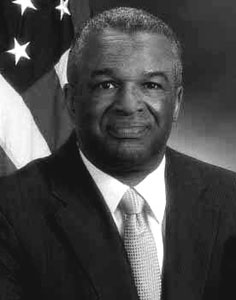 |
on Sims, vice secretary Housing
and Urban Development. |
And what does Obama's Federal Government do? Look at Ron Sims...
HUD - Housing and Urban Development - Deputy Secretary Ron Sims oversees the 8,500 employees of the U.S. Department of HUD in Washington DC.
Sims’s unorthodox approach, particularly in a government agency with $44 billion in discretionary budget authority in FY 2010, stems from his time as a three-term county executive for King County in Washington state, the 13th largest county in the country, where he attracted national attention for his work on urban development, affordable housing, transportation, and homelessness, as well as funded nearly 6,000 housing units. Sims brings a new philosophical orientation to HUD that emphasizes both public and private equity, innovation, and long-term sustainability..
Can you tell us some specific examples from your travels around the rest of the country of exciting, new approaches that HUD should be looking to to emulate?
“There’s a good example from Cleveland related to Section 3 requirements—when you have HUD money, that’s supposed to create jobs. While I was there, a person was telling me about the Evergreen Cooperative Initiative [launched in 2007 by a working group convened by the Cleveland Foundation]. She was telling me about the excellent hospitals in Cleveland, that all suffered from a laundry issue. All of them knew they needed new laundry capacity, but none of them wanted to build a laundry on their own.
So the Cleveland Foundation says, “Why don’t we create a co-op that will do your laundry? And the people who are going to work in that co-op and be the equity holders of that co-op will be people who’ve had erratic employment histories, that are poor, that might have been in and out of jail. They will be the people that we will train to work in that laundry, and then it’ll be really well managed on top.”
So I said to the people in HUD, “Have we ever thought about telling [residents of poor communities], ‘Why don’t we make you the employer?’” Isn’t that what we really want to achieve in the end: self-sustaining employment, to have them take a risk so they are the ones knowing they have to go to work because, in the end, it is their company?
Now that’s what they did in Cleveland at the Evergreen Co-op. They’ve applied it now to solar, and they’re now doing a plan so that they will grow crops in the winter in these large greenhouses and sell them, but again, all the participants will be people out of these poorer communities. Brilliant.
So we are now changing what we call Section 3. We have a team that we’ve sent out in the country to look at innovative practices, and then we’re going to create training sessions. All because I was out in Cleveland.”
From Shelterforce Interview: Ron Sims http://www.shelterforce.org/article/2110/shelterforce_interview_ron_sims/P0
The Mondragon Cooperative of the Basque Country, Spain
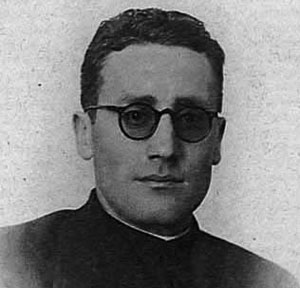 |
Don José María Arizmendiarrieta (1915-1976) |
The Mondragon Corp. (MCC), based in northern Spain, is a multilayered business group with 256 independent companies (more than 100 of which are worker-owned cooperatives) that employs almost 100,000 people. It has long been legendary among scholars and activists seeking to bolster workers' rights.
The Mondragon story began in 1941, when a Catholic priest, Jose Maria Arizmendiarrieta (often shortened to Arizmendi), found in the Basque town war-torn devastation where there had been a thriving manufacturing base. He opened a polytechnic school, which in 1956 spawned its first cooperative, a stove factory. Half a century later, the Mondragon enterprise encompasses firms making everything from machine tools to electronics to bicycles, along with a retail division, a university and a significant financial sector, with the large cooperative bank Caja Laboral at its core.
While many think of cooperatives as a small-scale hippie mainstay, the Mondragon Corp. is huge, hard-nosed business-wise and successful; in 2008, with Spain's economy in the doldrums, MCC's income rose 6%, to 16.8 billion euros. In 2009 the income was down to 14.8 billion euro, but no one of the worker-owners (or of the hourly employees) lost his job. The Mondragon Corp. maintains its commitment to one-worker, one-vote democratic governance through a complex, carefully honed organizational structure in which the corporation serves as a kind of meta-cooperative for the individual companies. Through representatives and resources drawn from the larger network, it provides support for planning, research and generation funding for new businesses.
One hallmark of the Mondragon model is its use of capital. Rather than flowing into the pockets of executives and outside investors, a company's profits are distributed in a precise, democratic way: set aside as seed money for new cooperatives; distributed to regional nonprofits; or pooled into shared institutions like the university and research center. In other words, each individual cooperative gains long-term benefits from the financial assets of the whole.
The Cleveland model
|
Gar Alperovitz,
professor of
political economy
at the University
of Maryland. |
The “Cleveland model,” as Evergreen has already been dubbed, creates “a way to stabilize jobs in an area as well as democratize ownership,” says Gar Alperovitz, professor of political economy at the University of Maryland and a founding principal of the Democracy Collaborative, a nonprofit organization that has advised Evergreen. He says part of the strategy has been to address growing sectors of the economy, such as health care and energy. To have a major impact on the regional economy, manufacturing has to be brought in, says Alperovitz. “We're thinking about similar approaches with bullet trains and mass-transit vehicles, asking the question, How can some of that production be organized according to this model?”
One can indeed preach purity, but talk is cheap, and moreover, people know that. The significance of Mondragon is twofold: it represents a positive vision of freedom in work, a community that is democratically controlled by its members. The ideal of democracy, to which everyone gives lip service, is actually practiced here. But it also represents something that works, and that in turn constitutes a statement about human nature, establishing beyond controversy that people can manage complex social tasks via democratic organization. If a picture is worth a thousand words, an effective working model is worth at least a thousand pictures.
Probably the most frequent criticism of utopian thinking is that it flies in the face of human nature, which has powerful propensities for evil as well as good. This argument is not one that can be settled in the abstract. The value of Mondragon is that it speaks to the claim of the weakness and fallibility of human nature in specific and concrete ways.
Whereas the Webbs and others have long argued against the viability of worker cooperatives on the basis that they tend to degenerate into capitalist enterprises, Mondragon has clearly shown that this is not true. Not only does Mondragon work, but it works a lot better than its capitalist counterparts, and it grows faster. By showing that one can combine democracy with efficiency, it gives the lie to a basic article of capitalist dogma about human nature: that people are naturally lazy and irresponsible and will work only when given the twin incentives of the carrot and the stick. Another objection has been raised: Structure is brainlessly equated with hierarchy and bureaucracy, and hence the complex organizational structure of a system such as Mondragon is written off out of hand. But structurelessness breeds tyranny: informal cliques develop, hidden leaders emerge who wield power behind the cloak of an espoused equality.
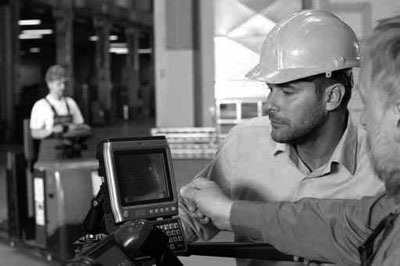
Mondragon is worth studying because it works, and the argument can be made that utopian theory must always confront the practical since the burden of proof is on the theorist. The problem with capitalism and, more generally, with coercive industrial systems of whatever persuasion, is not that they don't work; they do deliver the goods, but in the process grind up human beings. For the US cooperative movement the only answer to this state of affairs is to prove that a better system also works; theory alone simply will not do. And, if we wish to claim that something better than Mondragon needs to be built, then it is incumbent on us to do it. Interestingly enough, the US coop movement studied also the Italian cooperatives, but prefers the Mondragon from the Basque country, did they perhaps find that the Italian model is not enough democratic?
Reference Material |
A list of DVD and film on cooperatives
http://cultivate.coop/wiki/Films_and_Videos_on_Cooperatives
A series of video
http://www.community-wealth.com/news/video.html
Some news and Opinions on the agreement between Mondragon and the United Steelworkers
http://www.geonewsletter.org/node/411
Econ-Utopia: Steelworkers and Mondragon Collaborate!
Tuesday, November 10, 2009 by Center for Popular Economics
Interesting article on existing cooperativesi and on the USW-Mondragon agreement: http://www.fguide.org/?p=234
On the Time magazine Web site, Judith Schwartz reports on the Cleveland Evergreen worker co-op project, and on the inspiration from Mondragon. http://www.time.com/time/business/article/0,8599,1947313,00.html
New York Times
November 23, 2009 The Case for Worker Co-ops, very addictive and a piece of a general nature which includes many useful links and references, Nancy Folbre, a professor of economics at the University of Massachusetts Amherst. http://economix.blogs.nytimes.com/2009/11/23/the-case-for-worker-co-ops
Aaron Smith at CNN Money profiles six worker co-ops, including Isthmus Engineering in Madison, WI, and Ronin Tech Collective di Brattleboro, VT. http://money.cnn.com/galleries/2009/smallbusiness/0909/gallery.worker_owner_coop.smb/index.html
http://www.isthmuseng.com
http://www.ronin.coop
John Abrams, co-founder and CEO of the worker coop South Mountain Company and author of "Companies We Keep", explores the ramifications of the agreement on his blog:
http://www.companywekeep.net/co-ops-on-the-rise/
The United Steelworkers’ press release
http://www.usw.org/media_center/releases_advisories?id=0234
An PDF image of the signed agreement
http://assets.usw.org/Releases/agree_usw_mondragon.pdf
John MacNamara of worker-owned Union Cab was the conference that accompanied the signing of the agreement. He was able to report live some of the questions and answers - part one and part two.
http://www.unioncab.com
http://rochdale.livejournal.com/51855.html
http://rochdale.livejournal.com/52206.html
On Friday 30 October, 2009, the developers of worker co-op Andrew McLeod and Lisa Stolarska spoke with Rob Witherell, who is coordinating the plan for the Steelworkers' union, to discuss how the plan is developed and what is expected . Andrew's blog has a sinopsis of the discussion.
http://coopgeek.wordpress.com/2009/11/02/the-latest-from-united-steelworkers
Carl Davidson covers the answers from the community 'activists in the U.S. in a piece of SolidarityEconomy.net.
http://www.solidarityeconomy.net/2009/11/03/steelworkers-aim-at-job-creation-with-worker-owned-factories/
Andrew recently visited Mondragon and the surrounding area, and has written a beautiful four-part blog on this trip.
http://coopgeek.wordpress.com/2009/10/14/mondragon-1-arrival-in-the-basque-country/
Mondragon 2: Getting down to business
Visit to Mondragon – interesting blog (part 2) with critics to what they do outside Spain.
http://coopgeek.wordpress.com/2009/10/15/mondragon-2-getting-down-to-business/
Chroma Named to WorldBlu List of Most Democratic Workplaces
http://www.chroma.com/newsevents/articles/chroma-named-worldblu-list-most-democratic-workplaces
Ajowa Ifateyo, del collettivo GEO, ha scritto queste pagine nel blog sul suo viaggio attraverso Mondragon.
Mondragon Training Journal – May 16, 2011: What’s the Word on Mondragon
Mondragon Training Journal-May 17, 2011: A Visit to Mondragon University
Mondragon Training Journal: May 18, 2011: Saiolan, Mondragon’s Business Innovation Center
Mondragon’s Corporate Model: "The Workers Have the Power" |

